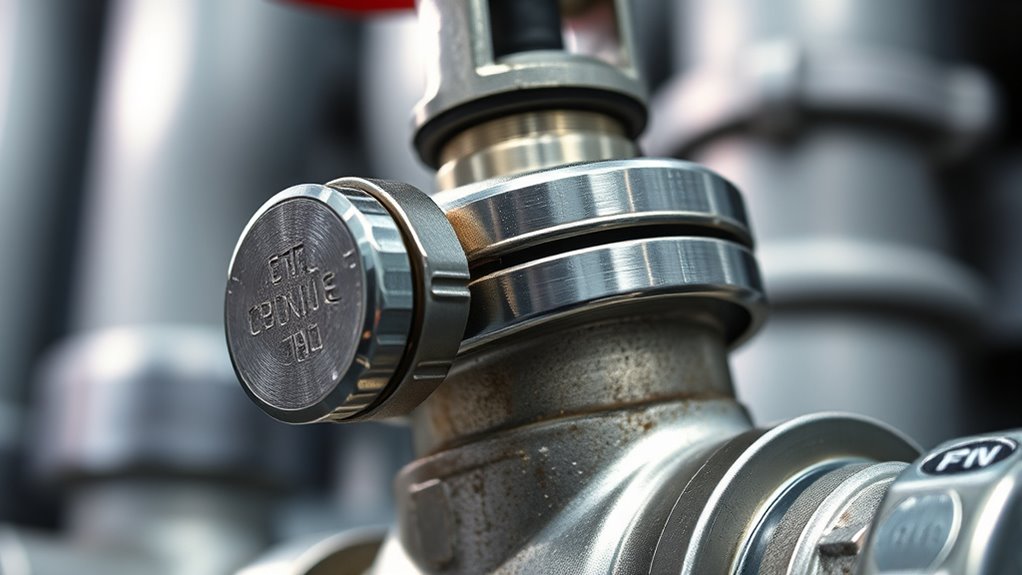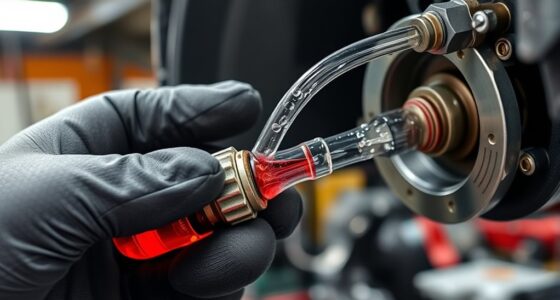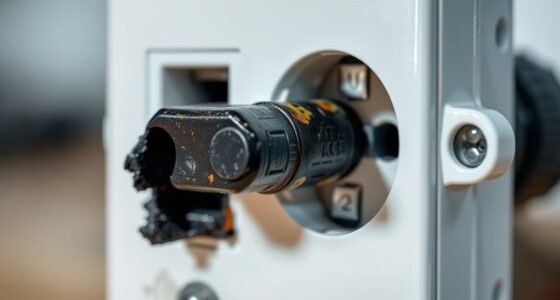If your control valve’s detent isn’t holding, start by inspecting the mechanism closely for signs of wear, corrosion, or debris buildup. Clean all components thoroughly and replace worn parts like springs or detent balls. Confirm everything is properly aligned and securely fastened. Check system pressure and external factors like vibrations. Regular maintenance and proper assembly can prevent future issues. To get detailed steps and tips, keep exploring more solutions to effectively restore your valve’s performance.
Key Takeaways
- Inspect and clean the detent components, replacing worn or damaged parts as needed.
- Ensure proper lubrication and secure assembly to maintain tension and alignment.
- Check system pressure and flow to confirm they meet manufacturer specifications.
- Look for external vibrations or forces that might weaken the detent engagement.
- Follow safety protocols, depressurize the system, and consult professionals if issues persist.

If your control valve detent isn’t holding, it can lead to unpredictable operation and system malfunctions. This issue often results in the valve shifting unexpectedly, causing process inconsistencies or even equipment damage. To address this problem effectively, you need to follow proper maintenance tips and troubleshooting procedures to identify the root cause and restore reliable control.
First, start by inspecting the detent mechanism itself. Over time, wear and tear can weaken the spring tension or damage the detent ball or plunger. Check for signs of corrosion, debris buildup, or physical damage. Cleaning the components thoroughly with a suitable solvent can often resolve minor contamination that prevents the detent from engaging properly. If cleaning doesn’t work, consider replacing worn parts such as springs or the detent ball, which are usually inexpensive and easy to swap out. Regular maintenance tips include lubricating moving parts with compatible lubricants to prevent corrosion and ensure smooth operation. Also, ensure that the assembly is properly aligned and securely fastened, as loose fittings can compromise the detent’s ability to hold. Maintaining proper pressure levels is essential, as fluctuations can interfere with the detent’s engagement and holding capacity.
Troubleshooting procedures should also involve verifying the system’s pressure and flow conditions. Excessive pressure fluctuations or incorrect pressure settings can interfere with the detent’s engagement. Use a pressure gauge to monitor the system and compare it with manufacturer specifications. If pressure is too high or too low, adjust the control settings accordingly. Additionally, inspect the valve’s installation environment for any vibration or external forces that might cause the detent to disengage. Unstable mounting or external vibrations can weaken the detent’s hold over time. If you find that the problem persists after cleaning and adjustments, consider testing the entire control valve assembly on a bench or with a test rig. This can help determine whether the issue lies within the valve itself or elsewhere in the system.
When troubleshooting, always follow safety protocols—depressurize the system and wear appropriate protective gear before disassembling any parts. Document your findings and the steps taken, so you can track recurring issues or inform future maintenance routines. If you’re unsure about any component or if the problem seems complex, consulting the manufacturer’s guidelines or seeking professional assistance can save you time and prevent further damage. Remember, consistent maintenance and diligent troubleshooting procedures are key to preventing detent failures and ensuring your control valve operates smoothly and reliably.
Frequently Asked Questions
Can a Damaged Detent Cause Pressure Fluctuations?
Yes, a damaged detent can cause pressure fluctuations. When the detent material wears out or breaks, it can’t hold the valve in position properly, leading to unstable pressure control. This instability affects pressure stability by allowing unintended movement or bouncing of the valve. Inspect the detent for damage or wear and replace it with the correct material to restore proper pressure regulation and prevent fluctuations.
How Often Should Control Valve Detents Be Inspected?
Imagine a plant where a control valve’s detent suddenly slips, causing inconsistent pressure. You should inspect the detent during routine maintenance scheduling, ideally every 3 to 6 months, depending on usage. Regular detent inspection helps catch wear early, preventing failures. By establishing a consistent maintenance schedule, you guarantee the control valve operates smoothly, reducing downtime and avoiding costly repairs from unnoticed detent issues.
Are There Specific Tools Required to Replace a Detent?
You’ll need specific tools for detent removal, and choosing the right ones depends on your valve’s design. Typically, a small punch or pick helps remove the old detent, while a screwdriver or Allen wrench may be necessary for disassembly. Make sure your tools are compatible with the valve to avoid damage. Always consult the manufacturer’s guidelines to guarantee tool compatibility and proper detent replacement procedures.
What Safety Precautions Are Necessary During Maintenance?
During maintenance, you should always wear appropriate safety gear like gloves and goggles to protect yourself. Follow lockout procedures meticulously to make certain the system is fully isolated and de-energized before starting work. This prevents accidental activation or release of pressure, reducing the risk of injury. Always double-check that all safety measures are in place, and communicate with your team to maintain a safe working environment throughout the process.
How Do Temperature Changes Affect Detent Performance?
Temperature tweaks can tarnish detent durability, disrupting reliable operation. As temperatures rise or fall, material compatibility issues may cause the detent to weaken or stick. You should verify calibration procedures regularly to guarantee proper functionality, especially when experiencing temperature shifts. Keep an eye on material resilience, and consider adjusting or replacing parts to maintain peak performance. Proper maintenance minimizes mishaps and maximizes the mastery of your control valve’s dependable detent hold.
Conclusion
If your control valve detent refuses to hold, don’t panic—think of it as just a minor hiccup in an otherwise flawless system. Double-check for dirt, wear, or misalignment, and replace any faulty parts. Regular maintenance can prevent this issue from snowballing into a catastrophe. Remember, a loose detent isn’t just a small problem; it’s the Achilles’ heel of your entire setup. Act quickly, and your system will run smoother than a well-oiled machine!









